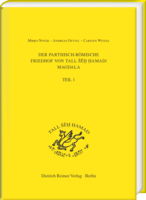|
|
more titles of the subject:
Im Grabungsabschnitt „Mittlere Unterstadt II“ sind insgesamt 732 Grabkomplexe eines parthisch-römischen Gräberfeldes (Friedhofs) ausgegraben worden. Sie sind einschließlich der anthropologischen Untersuchungen in den Bänden BATSH 5, 13-1 und 13-2 publiziert. Der abschließenden Bewertung von B. Wehry zufolge (BATSH 13-2) wurde das Gräberfeld in vier Zeitstufen vom Ende des 3. Jahrhunderts v. Chr. bis ins 3. Jahrhundert n.Chr. belegt. Zusammen mit den gleichzeitigen Siedlungsbefunden im Grabungsabschnitt Tell/Zitadelle (BATSH 2) entsteht das seltene Ensemble einer Stadt und eines Gräberfeldes, das mit dem Ortsnamen „Magdala“ identifiziert werden kann. Mit Blick auf die bekannten eher dürftigen schriftlichen und materiellen Zeugnissen trägt das Ensemble „Stadt und Friedhof von Magdala“ erheblich zu unser Kenntnis über parthisch-römische Berührungen im umkämpften Grenzbereich am Habur und am Mittleren Euphrat bei.
In diesem Band werden die archäologischen Befunde von 313 Grabkomplexen vorgelegt (M. Novák und A. Oettel, Kap. X). M. Novák typologisiert die Gräber (Kap. II), A. Oettel die Beigaben (Kap. III), und C. Römer handelt die Keramik ab (Kap. IV). Daraus ergibt sich eine erste chronologische Bewertung (M. Novák und A. Oettel, Kap. V). In Kap. VI folgt dann die Darlegung der Ergebnisse der anthropologischen Untersuchungen von C. Witzel, H. Schutkowski und B. Ehlken. Auf der Grundlage dieser beiden Eckpfeiler nehmen M. Novák und A. Oettel eine kultursoziologische Interpretation (Kap. VII) und eine Einordnung in den kulturhistorischen Kontext vor (Kap. VIII), in dem die Bedeutung für Nordmesopotamien diskutiert wird. In the excavation unit „Central Lower Town II” 732 graves of a Parthian-Roman cemetery were excavated. Including the anthropological investigations, they are published in the volumes BATSH 5, 13-1, and 13-2. According to the final assessment by B. Wehry (BATSH 13-2) the cemetery was occupied in four intervals from the end of the 3rd century BC to the beginning of the 3rd century AD. Corresponding to the excavated levels of a contemporary settlement on the citadel/Tell published in BATSH 2 this evidence constitutes a rare ensemble of a town with its adjacent cemetery and of its population that is associated with the place name Magdala. In view of the known rather scanty textual and material sources this archaeological evidence contributes to our knowledge about the Parthian-Roman contacts in this heavily contested border region of the Habur and the Middle Euphrates. This volume catalogues the archaeological record of 313 graves (M. Novák and A. Oettel, chap. X). They are classified in chap. II (M. Novák); the grave goods are presented in chap. III (A. Oettel), and the pottery in chap. IV (C. Roemer). On this basis a preliminary chronological assessment is derived in chap. V (M. Novák and A. Oettel). The results of the anthropological investigations are presented in chap. VI (C. Witzel, H. Schutkowski, B. Ehlken). Based on these two columns of evidence M. Novák and A. Oettel give a socio-cultural interpretation (chap. VII) and an assessment of the cultural-historical context (chap. VIII) in which they discuss the significance of this new archaeological evidence. |






